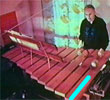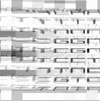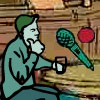 And while we’re on the subject of remixed field recordings, here’s an inspired online project, initiated by the New York Tenement Museum, which sets out to explore the formation of identity in a place in terms of the sounds of that place.
And while we’re on the subject of remixed field recordings, here’s an inspired online project, initiated by the New York Tenement Museum, which sets out to explore the formation of identity in a place in terms of the sounds of that place.
On a map of New York’s Lower East Side, a series of dots are displayed which correspond to site-specific recordings of ambient noise, musical performances and interviews with local residents. By moving the positions of five interconnected points, a visitor can create and save a mix of these recordings to produce their own environmental sound “folk song”. (via We Make Money Not Art)
A lovely idea, beautifully realised… And something for you to play with and enjoy over the festive season.
Happy Holidays everyone.
 OK, this is not only one of the most extreme time wasters on the web, but (if you follow it through to completion) a serious test of endurance...Someone far geekier than you could ever hope to be has written a Flash app that lets you select notes for each of the digits from 0 to 9, then uses these as the basis for a musical rendition of the first 10,000 digits of pi... By my (highly inaccurate) calculations, that's close to 2 hours of random crap synth tones... You have been warned.
OK, this is not only one of the most extreme time wasters on the web, but (if you follow it through to completion) a serious test of endurance...Someone far geekier than you could ever hope to be has written a Flash app that lets you select notes for each of the digits from 0 to 9, then uses these as the basis for a musical rendition of the first 10,000 digits of pi... By my (highly inaccurate) calculations, that's close to 2 hours of random crap synth tones... You have been warned.
 And now a couple of online Flash playthings that I've come across recently. First up, is a set of virtual instruments based on music-making devices created by legendary American composer and patron saint of weird instrument builders, Harry Partch. In the collection, you will find the boo, the chromolodeon, a variety of modified marimbas, cloud chamber bowls, kitharas, and other just intonation goodies. (In some cases, the playing of the instruments is accompanied by matching stills of Partch et al striking the notes so you can create some great jerky performance animations as well.) These virtual instruments come courtesy of the American Mavericks radio series.
And now a couple of online Flash playthings that I've come across recently. First up, is a set of virtual instruments based on music-making devices created by legendary American composer and patron saint of weird instrument builders, Harry Partch. In the collection, you will find the boo, the chromolodeon, a variety of modified marimbas, cloud chamber bowls, kitharas, and other just intonation goodies. (In some cases, the playing of the instruments is accompanied by matching stills of Partch et al striking the notes so you can create some great jerky performance animations as well.) These virtual instruments come courtesy of the American Mavericks radio series.
For something a wee bit more abstract, try the Hammond Flower, a series of radiating triangulated faders that control the levels of a set of Hammond organ chords... Another interesting experiment in musical interfaces and a glorious waster of time... (via Waxy)
 ...And try to build music mixers, they probably come up with stuff like this... That's the only way I can explain it... Ear-pummeling repetitive loops, an incomprehensible interface, random flashes of 3D cars, office furniture, cash register text... Surrender your mind to Looptracks now...
...And try to build music mixers, they probably come up with stuff like this... That's the only way I can explain it... Ear-pummeling repetitive loops, an incomprehensible interface, random flashes of 3D cars, office furniture, cash register text... Surrender your mind to Looptracks now...
 Here's another one of those interactive online music projects that I'm a big fan of... This one is a giant progammable music box, with lights installed in the barrel to illuminate the melodies entered into it. Its on display at the Tisch School of Arts at NYU, and what's particularly notably about it is that anyone who hops on to the website can program in a melody which can be played on the music box by other users.
Here's another one of those interactive online music projects that I'm a big fan of... This one is a giant progammable music box, with lights installed in the barrel to illuminate the melodies entered into it. Its on display at the Tisch School of Arts at NYU, and what's particularly notably about it is that anyone who hops on to the website can program in a melody which can be played on the music box by other users.
 Stanza is a UK-based multimedia artist who has taken the DNA from a sample of his own blood and used it as the basis for a fascinating collection of online artworks/interactive playthings. One of these is Open Source, in which Stanza's X chromosome has been translated into 25 different electronic instrument loops that can be mixed in real time. (Be warned: when you first open it, all the loops will be "on", so you'll get complete (but not entirely unenjoyable) cacophony.)
Stanza is a UK-based multimedia artist who has taken the DNA from a sample of his own blood and used it as the basis for a fascinating collection of online artworks/interactive playthings. One of these is Open Source, in which Stanza's X chromosome has been translated into 25 different electronic instrument loops that can be mixed in real time. (Be warned: when you first open it, all the loops will be "on", so you'll get complete (but not entirely unenjoyable) cacophony.)
Because it's based on DNA, the range of notes/sounds in each loop isn't terribly wide. (After all, there are only 4 "letters" in the DNA alphabet - A, C, G and T.) So most of what you produce will sound like some epileptic Phillip Glass out-take. But still... its a pretty damn addictive time-waster! (And if you ever tire of it, you can always go buy a DNA-patterned bedspread from the "online store".)
 This week's online music toy is A Break in The Road, a great little field recording 'n' sequencing Flash adventure game, in which you are sent around a typical London suburb with a minidisc to record a variety of everyday sounds. These include everything from carpet-beating, banging gates and construction noise; to arcade machines, overheard rants at the local boozer, and klezmer music from a Kosher deli. Once you have these on disc, you then have to sequence them together into a track to play at a mate's club. The track is then rated by the club's crowd (Luckily, they don't seem to be too demanding...) (via The Null Device)
This week's online music toy is A Break in The Road, a great little field recording 'n' sequencing Flash adventure game, in which you are sent around a typical London suburb with a minidisc to record a variety of everyday sounds. These include everything from carpet-beating, banging gates and construction noise; to arcade machines, overheard rants at the local boozer, and klezmer music from a Kosher deli. Once you have these on disc, you then have to sequence them together into a track to play at a mate's club. The track is then rated by the club's crowd (Luckily, they don't seem to be too demanding...) (via The Null Device)